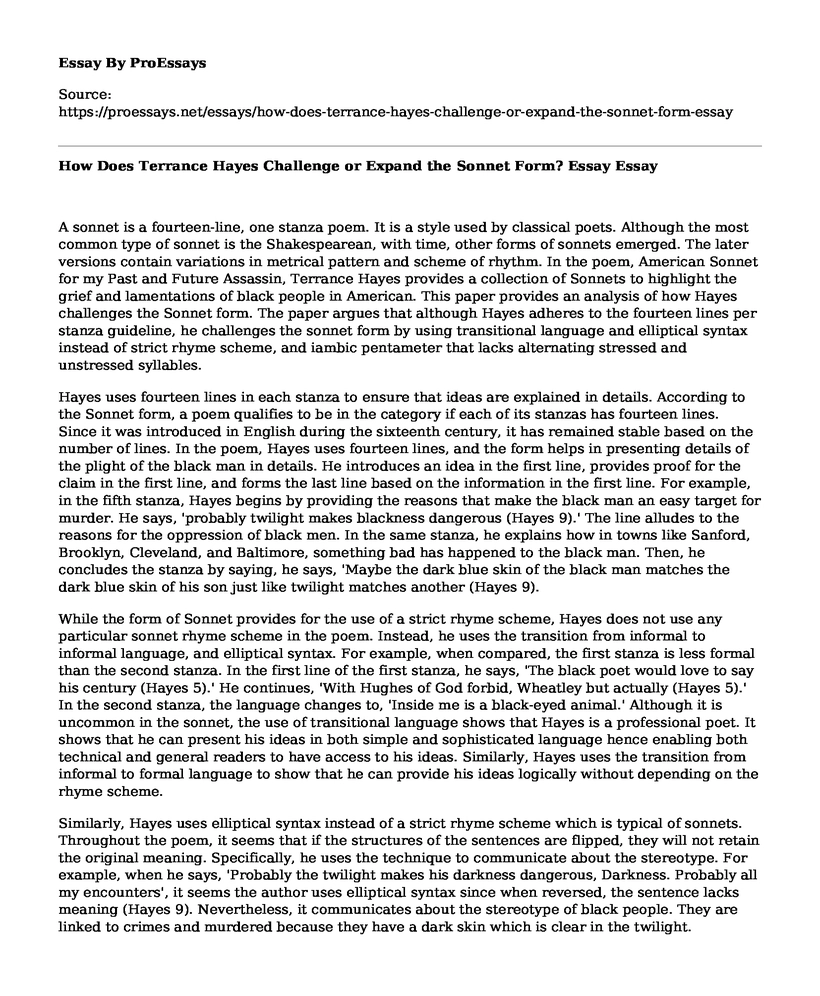A sonnet is a fourteen-line, one stanza poem. It is a style used by classical poets. Although the most common type of sonnet is the Shakespearean, with time, other forms of sonnets emerged. The later versions contain variations in metrical pattern and scheme of rhythm. In the poem, American Sonnet for my Past and Future Assassin, Terrance Hayes provides a collection of Sonnets to highlight the grief and lamentations of black people in American. This paper provides an analysis of how Hayes challenges the Sonnet form. The paper argues that although Hayes adheres to the fourteen lines per stanza guideline, he challenges the sonnet form by using transitional language and elliptical syntax instead of strict rhyme scheme, and iambic pentameter that lacks alternating stressed and unstressed syllables.
Hayes uses fourteen lines in each stanza to ensure that ideas are explained in details. According to the Sonnet form, a poem qualifies to be in the category if each of its stanzas has fourteen lines. Since it was introduced in English during the sixteenth century, it has remained stable based on the number of lines. In the poem, Hayes uses fourteen lines, and the form helps in presenting details of the plight of the black man in details. He introduces an idea in the first line, provides proof for the claim in the first line, and forms the last line based on the information in the first line. For example, in the fifth stanza, Hayes begins by providing the reasons that make the black man an easy target for murder. He says, 'probably twilight makes blackness dangerous (Hayes 9).' The line alludes to the reasons for the oppression of black men. In the same stanza, he explains how in towns like Sanford, Brooklyn, Cleveland, and Baltimore, something bad has happened to the black man. Then, he concludes the stanza by saying, he says, 'Maybe the dark blue skin of the black man matches the dark blue skin of his son just like twilight matches another (Hayes 9).
While the form of Sonnet provides for the use of a strict rhyme scheme, Hayes does not use any particular sonnet rhyme scheme in the poem. Instead, he uses the transition from informal to informal language, and elliptical syntax. For example, when compared, the first stanza is less formal than the second stanza. In the first line of the first stanza, he says, 'The black poet would love to say his century (Hayes 5).' He continues, 'With Hughes of God forbid, Wheatley but actually (Hayes 5).' In the second stanza, the language changes to, 'Inside me is a black-eyed animal.' Although it is uncommon in the sonnet, the use of transitional language shows that Hayes is a professional poet. It shows that he can present his ideas in both simple and sophisticated language hence enabling both technical and general readers to have access to his ideas. Similarly, Hayes uses the transition from informal to formal language to show that he can provide his ideas logically without depending on the rhyme scheme.
Similarly, Hayes uses elliptical syntax instead of a strict rhyme scheme which is typical of sonnets. Throughout the poem, it seems that if the structures of the sentences are flipped, they will not retain the original meaning. Specifically, he uses the technique to communicate about the stereotype. For example, when he says, 'Probably the twilight makes his darkness dangerous, Darkness. Probably all my encounters', it seems the author uses elliptical syntax since when reversed, the sentence lacks meaning (Hayes 9). Nevertheless, it communicates about the stereotype of black people. They are linked to crimes and murdered because they have a dark skin which is clear in the twilight.
Hayes stresses syllables but not per the guidelines of a sonnet which provide that sonnet should be written in iambic pentameter which has ten beats in one line. For example, in the second line, he says, With Hughes or God forbid, Wheatley, actually' (Hayes 5). In this line, the emphasis is placed on the syllables of the word,'Wheatley' and 'actually.' Similarly, in the third line of the first stanza, the author says, 'it began with all the poetry weirdos & warriors, warriors (Hayes 5).' In this line, the syllables in the words,'weirdos & warriers, warriors' are emphasized. However, the emphasis and stress on the syllables do not follow the guidelines of an iambic meter which requires that a line should have 10 beats of alternating syllables which are stressed and unstressed.
Conclusion
In conclusion, the purpose of this paper was to provide an analysis of the poem, American Sonnets for My Past and Future Assassin by Terrance Hayes. The poem highlights the grievances of black men who are murdered based on the idea that people from their race are prone to committing crimes. The paper has shown that while this paper is a sonnet, it does not have a strict rhyme scheme and iambic meter which uses alternating stressed and unstressed syllables as provided by the guidelines of the sonnet. However, it meets the basic criteria of having fourteen lines in each stanza.
Works Cited
Hayes, Terrance. "American Sonnet for My Past and Future Assassin." Penguin Poets. (2018): 5-10.
Cite this page
How Does Terrance Hayes Challenge or Expand the Sonnet Form? Essay. (2022, Oct 23). Retrieved from https://proessays.net/essays/how-does-terrance-hayes-challenge-or-expand-the-sonnet-form-essay
If you are the original author of this essay and no longer wish to have it published on the ProEssays website, please click below to request its removal:
- Literary Essay - The Stylistic Devices Used to Present the Theme of Paralysis in Joyce's Dubliners
- Argumentative Essay on Macbeth and Lady Macbeth
- The Duality of a Man with Enron and the Lord of Flies: Paper Example
- The Role of the Narrator in Harper Lee's To Kill a Mockingbird
- Marxist Criticism on Mary Shelley's Frankenstein Essay Example
- Fathered by a White Landowner: Fredrick Douglass's Journey - Essay Sample
- Essay Example on Hamlet: Madness at the Centre of All Problems







